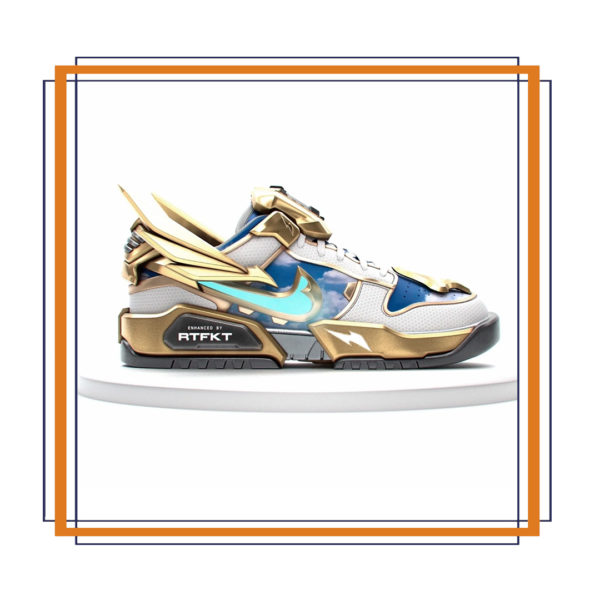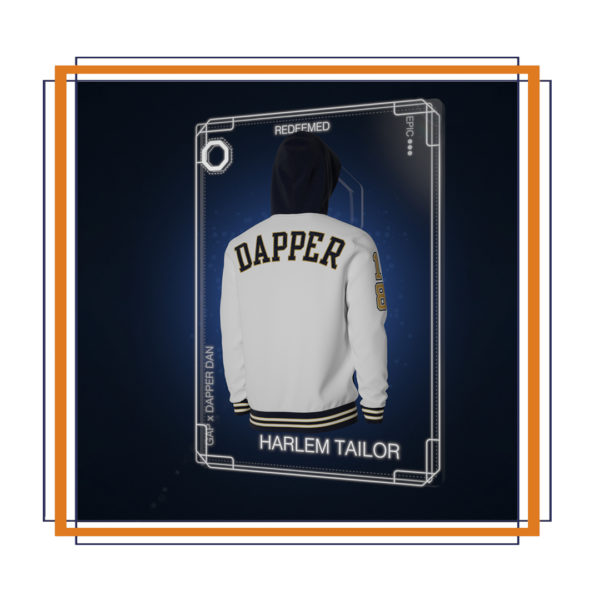A scientific report estimates that on a global level 35% of the microplastics found in oceans can be traced back to textiles. This makes the fashion industry the largest source of microplastic pollution for our oceans.
Not only this, but the production methods, water usage, and supply chains involved in clothing manufacturing leave a significant environmental impact.
However, one thing that isn’t taken into account when it comes to fashion’s environmental impact is NFTs. In the past 18 months the majority of big fashion houses and brands including Gucci, Balmain, Burberry and even GAP – have jumped on the NFT bandwagon.
Last year we found that the most popular blockchain, Ethereum – which is what is used to produce most NFTs – uses approximately 31 terawatt-hours (TWh) of electricity per year which is equivalent to the whole of Nigeria. A single Ethereum transaction has a carbon footprint equivalent to 140,893 Visa credit card transactions.
What do we know about NFTs?
An NFT is a digital asset that represents real-world objects like art, music, in-game items and videos. NFTs are part of the Ethereum blockchain so they are individual tokens with extra information stored in them.
NFTs were first introduced in early May 2014 when digital artist Kevin McCoy pioneered the first NFT, ‘Quantum’ on Namecoin. 2021 is when NFTs really hotted up with celebrities and artists investing heavily in the one of a kind artworks.
The environmental impact is a hefty fee to pay. We have done our own research into cryptocurrencies and how they jar the environment but what about NFTs? Similar to cryptocurrency, NFTs require unnecessarily large amounts of energy to be created and stored.
The Ethereum Energy Consumption Index found that every proof of work transaction taking place uses more than 260 kilowatt-hours of electricity. This is equivalent to the average U.S household over 9 days.
When did NFTs become valid in fashion?
2021 was the year that NFTs merged with fashion during the unequivocal period of what we can only describe as NFT fever.
In September 2021, Karl Lagerfeld dropped 777 NFTs that sold out in 33.77 seconds.
Digital fashion is quite a challenging concept for some to wrap their heads around as fashion is such a physical expression. However, as the metaverse expands minds and breaks concepts we are seeing more adoption of digital assets from art to baby Birkins.
The environment vs fashion
Greenwashing is prevalent in the fashion industry with more and more brands claiming that their products are more environmentally friendly than they actually are.
We’ve seen it before, the use of green buzzwords like ‘eco-friendly’, ‘sustainable’ and ‘environmentally friendly’ to help with marketing. When you dig a little deeper, you’ll find that brands don’t feel the pressure to support these claims because the lingo is enough to sell their products.
It’s easy to add 10% of recycled cotton to your line and sell off that but without the numbers to back up the claims, consumers should be wary of green sheen claims.
And now, on top of the production and exporting of garments, brands are producing energy guzzling NFTs.
Fashion & NFTs: Which brand is the least environmentally aware?
To uncover ‘the most and least environmentally friendly big brand NFT’ we looked at 10 NFT drops from 10 well known fashion brands and estimated how many kilowatt hours (kWh) all the transactions each launch consumed.
Some details regarding the research include:
- The kWh for each NFT drop is an estimate based on the number of transactions, the specific blockchain and its fee.
We identified the least environmentally friendly NFTs from fashion brands as;
1. adidas: Into the Metaverse

adidas are very vocal when it comes to their environmental conscience. They have an annual Environmental Impacts Report which addresses aspects including water efficiency, energy consumption, CO2e emissions and sustainable materials. The most recent version of the report claims that they aim “to achieve a 40% reduction in water intensity…by 2025” and “that 90% of our articles will be sustainable by 2025” among many other ambitious stats.
But, in the same year as these environmental claims were made, adidas launched NFTs in partnership with Bored Ape Yacht Club, Punks Comics and GMoney. They sold almost 30,000 NFTs in a line called ‘Into the Metaverse’, which made 5,924 ETH, roughly over $23 million in profits. Buyers were offered the opportunity to purchase special merch drops and become part of shaping what products and experiences adidas plans for its NFT-owning community.
Each NFT cost an average of 0.8 ETH which, around the time, equated to about $765. Due to the substantial amount of transactions related to adidas’ release – and the fact that gas prices were notably high at the time of research – we found that this would use around 25,000,000 kWh – which is a substantial amount of energy on the Ethereum blockchain.
To put it into perspective, in 2020 “the average annual electricity consumption for a U.S. residential utility customer was 10,715 kWh”. So the transaction of one NFT drop alone used more electricity than 2,500 US homes would in one year.
2. Nike: Crytpokicks

Similarly to adidas – their biggest competitor – Nike also clearly outlines their environmental targets. Their website states that they aim to have “65% absolute carbon reduction in owned or operated facilities and 30% reduction across our extended supply chain by 2030” as well as “10% waste reduction per unit in manufacturing, distribution, headquarters and packaging, through improved design and operational efficiency”.
However, in late 2021, Nike purchased a virtual shoe company that makes NFTs and sneakers for the metaverse. When the deal was announced, Nike put RTFKT’s lightning bolt logo alongside its swoosh in an attempt to push forward into the digital future.
The average sale price of Nike’s virtual sneakers was 6.7 ETH. The estimated energy used for the number of transactions was 672,810 kWh, making them the second most environmentally unfriendly.
3. Burberry x Blankos Block Party

In third place – and needing 379,562 kWh for their NFT translations – was Burberry. Selling for an average of 0.0558 ETH per NFT, the limited edition dropped in August last year.
While this is lower than both adidas and Nike’s NFTs, it is still a substantial amount on the energy-guzzling blockchain. It also isn’t in line with Burberry’s many environmental targets listed online, in which they claim their aim is to be “Climate Positive by 2040, going beyond net-zero by investing in initiatives to support wider climate change efforts beyond our value chain.”
The NFT drop – which took place in August 2021 – consisted of a shark named Sharky B, which was covered with Burberry’s summer monogram and could be purchased, upgraded and sold within the Blanko’s Block Party marketplace. As part of the collection, Burberry launched its own branded in-game accessories such as a jetpack, armbands and pool shoes.
On the other hand, there are some brands that are more environmentally friendly when launching themselves into the NFT market.
1. Balmain x Barbie

At less than 1 kWh per NFT, Balmain x Barbie was the most environmentally friendly fashion brand when it came to NFTs – and it all comes down to the blockchain they use. Flow blockchain provides environment-friendly transactions with little to no fee – in a 2021 tweet they claimed “Flow leverages an environment-friendly design via Proof-of-Stake that consumes thousands of times less energy than Proof-of-Work blockchains like the current Ethereum network”.
The NFT Balenciaga and Mattel launched on Flow blockchain, was an auction offering three unique Barbie avatars wearing digital versions of the collection – the highest bid received was $20,000. The top bidders also received a physical set of doll-sized Balmain clothing.
3. GAP x Dapper Dan

Close behind the most environmentally conscious NFT is GAP at 1 kWh per NFT. Selling for an average of 31 XTZ (Tezos).
The 48-hour auction featured single edition digital art designed by Dapper Dan and a physical jacket signed by Dap. All proceeds raised by the auction were donated to the Fifteen Percent Pledge, a non-profit organization committed to increasing opportunities for the Black community by increasing pipeline programs by 15%.
4. Ray-Ban x Extraweg

2021 saw the first ever NFT Ray-Ban aviator, with an overall energy usage of 1,824 kWh and selling for an average of 1.8 ETH.
Designed by Berlin-based German artist Oliver Latta (Extraweg) who is known for his provocative 3D motion designs used to express the emotions and struggles of society in the modern world. Ray-Ban organized a digital auction on OpenSea for customers to bid. All proceeds were donated to charity.
The full list of 10 fashion NFT drops from most to least environmentally friendly are:
|
Brand |
NFT |
Blockchain |
Price |
kWh |
|
adidas |
Into the Metaverse |
ETH |
Average Sale Price = 0.8, Current sale price 1.009 |
25,000,000 |
|
Nike |
Cryptokicks |
ETH |
Average Sale Price = 6.7 |
672,810 |
|
Burberry |
Blankos Block Party |
ETH |
Average Sale Price = 0.0558 |
379,562 |
|
Gucci |
Gucci Aria & Super Gucci |
ETH |
Average sale Price = 12.7 |
324,037 |
|
Louis Vuitton |
Louis: The Game |
ETH |
Free giveaway |
20,000 |
|
Asics |
Sunrise Red Collection |
ETH |
Average Sale Price = 0.47 |
17,518 |
|
Dolce & Gabbana |
Nine-piece collection |
ETH |
Average sale Price = 209 |
17,014 |
|
Ray-Ban x Extraweg |
The first ever NFT Ray-Ban Aviator |
ETH |
Sale Price = 1.8 |
1,824 |
|
GAP |
DAP x GAP collaboration |
XTZ |
Average Sale Price = 31, floor Price=0.46 |
1 |
|
Balmain x Barbie |
Barbie tries a new look: NFTs |
Flow |
Highest bid around 20,000 |
Less than 1 |
Countless fashion brands are getting on board for the NFT hype that keeps on giving but the contrast between adidas and Balmain x Barbie for example is extraordinary. While fashion brands are taking steps to be more eco-conscious it still pays to check the numbers following the words.
Methodology: The kilowatt hours (kWh) for each NFT drop is an estimate based on the specific number of transactions, the specific blockchain that the transactions were processed on and its fee.







